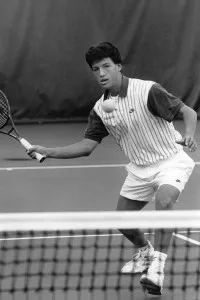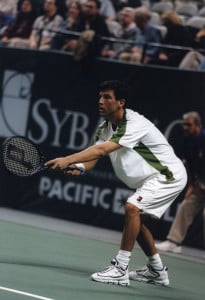Paul Goldstein ‘98 will always be a Stanford alumnus. The cardinal red hue on all of his Stanford athletic uniforms and jerseys runs through his veins. Many may remember Paul Goldstein as a standout men’s doubles player on the professional circuit, when he rose in the doubles rankings to 40th in 2007. However, for Stanford students and alumni, Goldstein will always be remembered as a captain of the Stanford tennis team, and as a player who helped lead his squad to a 104-6 record and four national championships in his four-year tennis career.

I had the honor of interviewing Goldstein a month after he was selected as Stanford’s new men’s tennis coach. When I met Goldstein, I was shocked that he looked like any other student on campus. He wore an oversized backpack, his shirt was rumpled and his multicolored high socks contrasted his shoes. His boyish features and friendly smile made him look like he was fresh out of college. When Goldstein led me into his cramped office, it was apparent from all the brown boxes lying around us that he was still settling into his role as head coach.
I first asked Goldstein what motivated him to want to return to Stanford and become Stanford’s new men’s tennis coach. I really wanted to understand Goldstein’s reasoning as to why he was coming back to Stanford now after graduating from his alma mater 14 years ago.
Was he looking for a change in scenery after working at a Sunnyvale clean energy company, Bloom Energy, for six and a half years, or had he always wanted to coach?
Before Goldstein answered my question, he stated that he was “excited and humbled to get this position and have the opportunity to lead this program. This program has meant and continues to mean a lot to [him].” Goldstein seemed like a man who was just happy to be back with his alma mater.
As for why Goldstein came back to apply for this job, the new tennis coach felt this opportunity was the one he had been waiting for.
“I’ve always stayed close to tennis. I’ve worked with some juniors [adolescent tennis players] on the court as well as served on the committees for the USTA (United States Tennis Association) as well as stayed close to the Stanford tennis program. I had other opportunities in the last six or seven years to get back into tennis full-time, but none of them were quite right. When this opportunity to come back to my alma mater came across, this was just the perfect fit for me. I’d like to be here for the next quarter century.”
***
In 2005, then-professional player Paul Goldstein finished as the highest-ranked player on the ATP circuit with a college degree. Goldstein said it took sacrifices to be able to manage both his budding tennis career and his academic work.
“The priority was figuring out a way to not only balance your academics and your tennis but also your social life,” he said. “In each case, you make sacrifices in each one of those for the other. An example of this case was when I was a junior in high school. When I was a junior in high school, I was invited to play in the Junior Australian Open, which conflicted with January finals.
“I passed on the opportunity to go to the Junior Australian Open in order to focus on my academics for that year. I felt junior year was a very important year academically. That’s an example of a tradeoff that you make, like skipping spring break to train for tennis on campus.”
Goldstein’s impressive resume sheds light on his illustrious career. He was inducted into the ITA (Intercollegiate Tennis Association) Hall of Fame in 2013, and now serves on the ITA Hall of Fame Committee that decides who will be inducted into the Hall of Fame in the future. Goldstein was also elected as a liaison for the ATP Player Council in 2006, as he was chosen for one of 10 positions out of the 1,500-1,600 ranked tennis players at the time. At the ATP Player Council, he worked with the other nine members to select the player representatives for the board of directors.

Although Goldstein’s resume as a player and representative was impressive, what was even more impressive was his humility as he talked about those two committee roles. When asked about his role as an ITA Committee member and how it felt to be inducted into the Hall of Fame, his answer was genuine and altruistic.
“It was certainly an honor to be inducted into the Hall of Fame in 2013,” he said. “I feel like I was there because of my teammates and my coaches throughout my college career, and I feel like I was sharing my honor with all of them. I was equally honored to be asked to be on the Committee.”
Even when I asked Goldstein about what factors led to his retirement at age 31, which can be a sensitive topic and question for athletes to answer, he was up front and forthcoming with his answer.
“My wife and I had our first child in June of 2007. So I played my last event at the U.S. Open in September of ‘07, and I could have kept playing a little bit, but I didn’t want to throw all of the child-bearing responsibilities on my wife,” Goldstein said. “I made that decision [to retire] there at that point from a family perspective. I was excited about trying things outside of tennis.”
Goldstein’s retirement from tennis led to his job at Bloom Energy, where he enjoyed the change of scenery. “It was a significant transition, you know, just from the environment of going to work every day outside and playing tennis and being competitive to going to work in an office everyday and having a steady commute, a much more consistent lifestyle for me at the time,” he said. “But, I think there is just no way to replace the competitiveness of playing a sport for a living. That was a significant transition there. At the same time, there were a lot of challenges and a lot of intellectual ways that I hadn’t been [challenged] quite as much previously. That was a really fun experience and I learned a ton from the people I worked with.”
***
Even though Goldstein has only had the job as tennis coach for a month, and despite the loss of three players to graduation, he is confident that this spring’s men’s tennis squad will be in pretty good shape from a leadership standpoint.
“We’ve got six upperclassmen, two seniors, and each of those guys have good leadership qualities in their personalities,” he said. “I feel really excited that we’re going to have good leadership on our team.
“I’m also real excited about some of the incoming freshmen…all of the freshmen are high-caliber players and I’ve gotten to know them over the summer and I think they’re high-caliber individuals as well. This group of guys, they all work hard and are there for each other. I’m just looking forward to getting to work and supporting the heck out of each other.”
Finally, Goldstein believes that this team — and himself — is going to make mistakes and learn from them, as well as work hard to succeed.
“One of my expectations [for this year] is I’m going to make mistakes and I’m going to learn a lot,” he said. “I expect my guys to be accountable for their own development. Each one of those guys have to have ownership to get better, because that’s what it’s going to take for the team to be successful. I expect us to work hard, I expect us to have a lot fun, because it’s not worth it if we’re not.”
***
I could not help but admire the man I had just interviewed. Goldstein had answered all of my questions thoughtfully, giving me great insight into his past and his future. I was also very impressed with Goldstein’s calm and magnanimous personality. He spoke highly of all of his tennis players and made it a point to tell me that he would support all of them throughout the season. Every athlete wants to be supported and taught by their coach, whether it be tennis or any other sport.
Since Goldstein had balanced academics and sports throughout his entire life, the new tennis coach could definitely sympathize with the players he would be coaching this year. That is an important quality of a good coach: the ability to relate to the athletes that he is teaching.
“Young student athletes are specialized — led to pursue a specific activity — in a sport at a younger age. It becomes harder for others to not go down that path [of being specialized in a sport] and not feel like that they are at a competitive disadvantage,” he said. “I think that’s the pressure. I’m a firm believer that there are a lot of different ways to [balance pressure between school and sports]. I think that there are a lot of viable paths towards having a successful college career and a successful professional career, and some of those paths include going to a regular school and maintaining your balance between your academics and your sport.”
Goldstein’s understanding of the pressures that student-athletes encounter every day will allow him to teach his team the importance of balancing work and play. With a coach at the helm who understands the trials and tribulations of being a collegiate tennis player, the future of Stanford men’s tennis should be bright. With a proven tennis winner at the helm, the skies are the limit for Goldstein and his crew.
Contact Matt Niksa at mattniksa80 ‘at’ gmail.com.
